Here is a list of infamous stock market crashes, economic bubbles and financial crises that have occurred throughout history. I am continuously writing about additional crises (including Enron, the mid-2000s housing bubble & the Stock Market Crash of 2008), so please keep checking back in the future.
The Dutch Tulip Mania (aka “Tulipomania”) of 1634-1637
Tulip Mania or Tulipomania was a speculative bubble in tulip bulbs that took place in the Netherlands from 1634 to 1637. Tulipomania occurred shortly after the tulip plant was introduced to Europe from the Ottoman Empire, in present-day Turkey. The tulip plant’s rarity and exotic beauty (as compared to plants that were common in Europe at the time) helped it to find immediate favor within Dutch high society, who cultivated and displayed tulips as a status symbol. As tulip prices rose to new heights, speculators began to buy tulip bulbs to “flip” later on for higher prices. Very soon, almost all classes of Dutch society were involved in tulip bulb speculation, with many trading all of their worldly possessions for a single tulip bulb. When tulip bulb prices became worth the equivalent of tens of thousands of dollars (in current values), many Dutch tulip speculators became fantastically wealthy. Alas, tulip bulb prices eventually peaked and soon imploded, bankrupting scores of speculators and throwing the Netherlands into a mild economic depression that lasted for many years.
(as compared to plants that were common in Europe at the time) helped it to find immediate favor within Dutch high society, who cultivated and displayed tulips as a status symbol. As tulip prices rose to new heights, speculators began to buy tulip bulbs to “flip” later on for higher prices. Very soon, almost all classes of Dutch society were involved in tulip bulb speculation, with many trading all of their worldly possessions for a single tulip bulb. When tulip bulb prices became worth the equivalent of tens of thousands of dollars (in current values), many Dutch tulip speculators became fantastically wealthy. Alas, tulip bulb prices eventually peaked and soon imploded, bankrupting scores of speculators and throwing the Netherlands into a mild economic depression that lasted for many years.
Read more about The Dutch Tulip Mania (aka “Tulipomania”)
The South Sea Bubble (1716-1720)
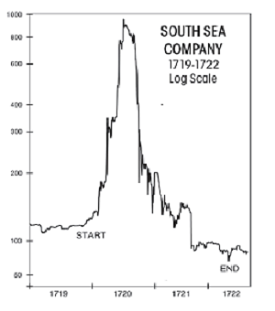 The South Sea Bubble was a speculative stock bubble in Britain in the early 18th century. The South Sea Bubble occurred at the same time as France’s Mississippi Bubble (see below). The bubble was centered on the shares of the South Sea Company, an international trading company that was granted special trading rights in the South Seas (now called South America) by the British government. South Sea Company executives spread rumors that greatly embellished upon the commercial value of the company’s trading rights, which caused its shares and soon the shares of similar companies to soar. Shortly after the stock speculation mania swept throughout Britain, with scientist Isaac Newton and author Thomas Swift (who wrote Gulliver’s Travels) taking part, the South Sea Bubble popped and caused a very severe economic crisis. When Newton lost a fortune in the crash, he famously remarked, “I can calculate the movement of the stars, but not the madness of men.”
The South Sea Bubble was a speculative stock bubble in Britain in the early 18th century. The South Sea Bubble occurred at the same time as France’s Mississippi Bubble (see below). The bubble was centered on the shares of the South Sea Company, an international trading company that was granted special trading rights in the South Seas (now called South America) by the British government. South Sea Company executives spread rumors that greatly embellished upon the commercial value of the company’s trading rights, which caused its shares and soon the shares of similar companies to soar. Shortly after the stock speculation mania swept throughout Britain, with scientist Isaac Newton and author Thomas Swift (who wrote Gulliver’s Travels) taking part, the South Sea Bubble popped and caused a very severe economic crisis. When Newton lost a fortune in the crash, he famously remarked, “I can calculate the movement of the stars, but not the madness of men.”
Read more about the South Sea Bubble
The Mississippi Bubble (1716-1720)
The Mississippi Bubble was a speculative stock bubble in France in the early 18th century that occurred at the same time as Britain’s South Sea Bubble. The seeds of the bubble were sown 1715, when France was nearly insolvent from war and sought the help of Scottish economic theorist John Law. Law decided to  create a national bank that would accept deposits of gold and silver currency and issue “paper” money or bank notes in return. Very soon, Law’s national bank began to issue much more paper currency than it received in gold and silver currency deposits, which created an inflationary economic “bubble boom.” One of Law’s international trading companies, the Compagnie des Indes, became one of the prime beneficiaries of the inflationary boom as its shares skyrocketed and created many millionaires (this is how the French word millionaire came about). For a time, it seemed as if France’s financial problems were over, until the Mississippi Bubble popped and Law’s trading company shares and paper bank notes plunged in value and threw France into an even greater economic crisis than it had before the bubble.
create a national bank that would accept deposits of gold and silver currency and issue “paper” money or bank notes in return. Very soon, Law’s national bank began to issue much more paper currency than it received in gold and silver currency deposits, which created an inflationary economic “bubble boom.” One of Law’s international trading companies, the Compagnie des Indes, became one of the prime beneficiaries of the inflationary boom as its shares skyrocketed and created many millionaires (this is how the French word millionaire came about). For a time, it seemed as if France’s financial problems were over, until the Mississippi Bubble popped and Law’s trading company shares and paper bank notes plunged in value and threw France into an even greater economic crisis than it had before the bubble.
Read more about the Mississippi Bubble
The British "Railway Mania" Bubble
Railway Mania was an economic bubble in the United Kingdom in the 1840s that involved a railroad development frenzy and a speculative bubble in the shares of railroad companies. Like the Dot-com bubble of the 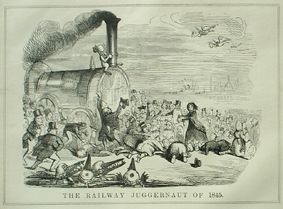 late 1990s, the British Railway Mania was the result of over-exuberance toward the business prospects of a disruptive innovation; though railroads are now a part of everyday life, they were once every bit as revolutionary as the internet was when it was first introduced. As railroad stocks soared to astounding heights, railroad companies massively overbuilt thousands of kilometers of railway lines throughout the UK. When the Railway Mania bubble eventually popped, many railroad companies went out of business, railway stock investors were ruined and enormous debts were left throughout the country.
late 1990s, the British Railway Mania was the result of over-exuberance toward the business prospects of a disruptive innovation; though railroads are now a part of everyday life, they were once every bit as revolutionary as the internet was when it was first introduced. As railroad stocks soared to astounding heights, railroad companies massively overbuilt thousands of kilometers of railway lines throughout the UK. When the Railway Mania bubble eventually popped, many railroad companies went out of business, railway stock investors were ruined and enormous debts were left throughout the country.
Read more about the British "Railway Mania" Bubble
The Florida Real Estate Bubble of the 1920s
The Florida Real Estate Bubble was a speculative property bubble that occurred in Florida in the early and mid-1920s. Up until the 1920s, the state of Florida was relatively unpopulated and large parts of the state consisted of undeveloped swampland. The Roaring Twenties  economic boom (and eventual bubble) of the time made many people wealthy and created a new class of people who could afford to go on vacations. Florida’s beautiful weather and beaches made it a natural destination for America’s burgeoning “leisure class” and land developers and speculators quickly took notice. Very soon, Florida land prices were skyrocketing and incredible amounts of money were flowing in from “Up North” – cold but affluent states such as New York, Connecticut and Massachusetts. The Florida Real Estate Bubble created many millionaires until it finally crashed in 1925 and devastated the state’s economy.
economic boom (and eventual bubble) of the time made many people wealthy and created a new class of people who could afford to go on vacations. Florida’s beautiful weather and beaches made it a natural destination for America’s burgeoning “leisure class” and land developers and speculators quickly took notice. Very soon, Florida land prices were skyrocketing and incredible amounts of money were flowing in from “Up North” – cold but affluent states such as New York, Connecticut and Massachusetts. The Florida Real Estate Bubble created many millionaires until it finally crashed in 1925 and devastated the state’s economy.
Read more about Florida’s 1920s Real Estate Bubble
The Stock Market Crash of 1929
America’s Stock Market Crash of 1929 was a powerful market crash that started in October of 1929 after the Roaring Twenties economic “bubble boom” finally popped. The Roaring Twenties were a time of peace and prosperity and the U.S. stock market soared as new technologies such as radio, 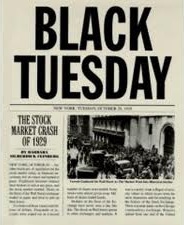 the automobile and airplanes became commercialized. Many Americans speculated in the stock market, often with large amounts of borrowed money, and became extraordinarily wealthy. By the fall of 1929, the stock market peaked and then plunged, financially-ruining many stock investors (some of whom jumped out of tall city buildings to their deaths). As the Crash of 1929 unfolded, thousands of banks failed, unemployment skyrocketed and the United States entered into the Great Depression, which lasted until the late-1930s.
the automobile and airplanes became commercialized. Many Americans speculated in the stock market, often with large amounts of borrowed money, and became extraordinarily wealthy. By the fall of 1929, the stock market peaked and then plunged, financially-ruining many stock investors (some of whom jumped out of tall city buildings to their deaths). As the Crash of 1929 unfolded, thousands of banks failed, unemployment skyrocketed and the United States entered into the Great Depression, which lasted until the late-1930s.
Read more about the Stock Market Crash of 1929
Kuwait’s Souk al-Manakh Stock Bubble & Crash
Perhaps the greatest speculative mania of all time was Kuwait’s Souk al-Manakh stock bubble in the early 1980s, which is as fascinating as it was devastating. The bull market began when  investing in local “Gulf Companies” became in vogue with Kuwaitis who wished to ride the coattails of the Middle East’s oil-driven economic boom of that time. A peculiar Kuwaiti custom allowed traders to pay for stocks using post-dated checks under the assumption that default would be unthinkable for cultural reasons. Unsurprisingly, avarice prevailed as some traders speculated in stocks paid for by billions of dollars worth of unsecured checks, causing Kuwait’s stock market to inflate like a balloon and pop in a most analogous manner.
investing in local “Gulf Companies” became in vogue with Kuwaitis who wished to ride the coattails of the Middle East’s oil-driven economic boom of that time. A peculiar Kuwaiti custom allowed traders to pay for stocks using post-dated checks under the assumption that default would be unthinkable for cultural reasons. Unsurprisingly, avarice prevailed as some traders speculated in stocks paid for by billions of dollars worth of unsecured checks, causing Kuwait’s stock market to inflate like a balloon and pop in a most analogous manner.
Read more about Kuwait’s Souk al-Manakh Stock Bubble & Crash
Black Monday – the Stock Market Crash of 1987
The Stock Market Crash of 1987 (also known as Black Monday) was the largest one-day market crash in history. The Crash of 1987 came on the heels of a spectacular stock bull market that started in 1982 that was fueled by a supercharged business environment that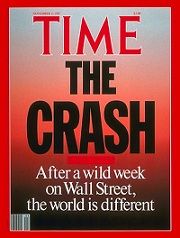 included hostile takeovers, leveraged buyouts and merger mania. The Dow stock index nearly doubled from 1986 until the fall of 1987, when the market began to drop and encouraged investment managers to use a new tool called “portfolio insurance” to protect their investments from further losses as the market fell. On Monday October 19th, 1987, an avalanche of very aggressive “sell” orders hit the market as investors began to panic, which triggered additional “sell” orders and more use of portfolio insurance. By the end of that day, Black Monday, the Dow lost an incredible 22.6% of its value.
included hostile takeovers, leveraged buyouts and merger mania. The Dow stock index nearly doubled from 1986 until the fall of 1987, when the market began to drop and encouraged investment managers to use a new tool called “portfolio insurance” to protect their investments from further losses as the market fell. On Monday October 19th, 1987, an avalanche of very aggressive “sell” orders hit the market as investors began to panic, which triggered additional “sell” orders and more use of portfolio insurance. By the end of that day, Black Monday, the Dow lost an incredible 22.6% of its value.
Read more about Black Monday – the Stock Market Crash of 1987
Japan’s Bubble Economy of the 1980s
During the late-1980s, Japan experienced its “Bubble Economy” in which real estate and stock prices soared along with the country’s overheated economy. Japan’s “Bubble Economy” era occurred 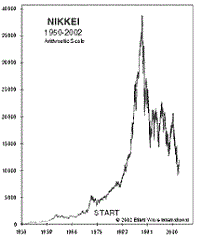 at the end of its three-decade old “Economic Miracle” that began after World War II and saw the country’s fortunes blossom as it became the world’s automobile and electronics manufacturing powerhouse. By the peak of Japan’s Bubble Economy in 1989, a house in Tokyo cost well over $2 million and the land underneath Tokyo’s Imperial Palace was rumored to be worth more than all of the land in California. Japan’s Bubble Economy peaked in late 1989 and the country’s highly-inflated stock and property markets began to crash. By 1992, Japan’s Nikkei stock index plunged to 15,000 from its peak of nearly 40,000 and the country’s real estate markets were decimated along with the rest of the economy. Since 1989, Japan’s Bubble Economy has deflated for over two decades, leading to this era being called the “Lost Decades.”
at the end of its three-decade old “Economic Miracle” that began after World War II and saw the country’s fortunes blossom as it became the world’s automobile and electronics manufacturing powerhouse. By the peak of Japan’s Bubble Economy in 1989, a house in Tokyo cost well over $2 million and the land underneath Tokyo’s Imperial Palace was rumored to be worth more than all of the land in California. Japan’s Bubble Economy peaked in late 1989 and the country’s highly-inflated stock and property markets began to crash. By 1992, Japan’s Nikkei stock index plunged to 15,000 from its peak of nearly 40,000 and the country’s real estate markets were decimated along with the rest of the economy. Since 1989, Japan’s Bubble Economy has deflated for over two decades, leading to this era being called the “Lost Decades.”
Read more about Japan’s Bubble Economy of the 1980s
The Collapse of Barings Bank (1995)
In 1995, a rogue trader named Nick Leeson single-handedly bankrupted the bank that financed the Napoleonic Wars, Louisiana Purchase and the Erie Canal. 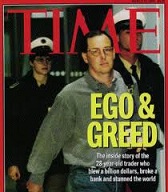 Founded in 1762, Barings Bank was Britain’s oldest merchant bank and Queen Elizabeth’s personal bank. Nick Leeson was employed by Barings to profit from low risk arbitrage opportunities between derivatives contracts on the Singapore Mercantile Exchange and Japan’s Osaka Exchange. A scandal ensued when Leeson left a $1.4 billion hole in Barings’ balance sheet due to his unauthorized derivatives speculation, causing the 233-year-old bank’s demise.
Founded in 1762, Barings Bank was Britain’s oldest merchant bank and Queen Elizabeth’s personal bank. Nick Leeson was employed by Barings to profit from low risk arbitrage opportunities between derivatives contracts on the Singapore Mercantile Exchange and Japan’s Osaka Exchange. A scandal ensued when Leeson left a $1.4 billion hole in Barings’ balance sheet due to his unauthorized derivatives speculation, causing the 233-year-old bank’s demise.
Read more about Nick Leeson & the Collapse of Barings Bank
The Dot-com Bubble (Late 1990s)
The Dot-com Bubble was a speculative bubble in the shares of early internet companies called “Dot-coms.” From the mid to late-1990s, technology company stocks in the Nasdaq stock index soared to incredible heights, 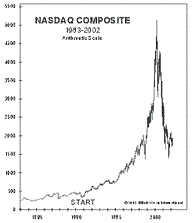 making scores of investors and technology company founders extremely wealthy. At this time, many people began to believe that technology had led to the creation of a “New Economy” where the traditional business cycle and recessions were a thing of the past. These “New Economy” beliefs led to excessive risk-taking in business and investments as Dot-com companies went public (such as the infamous Pets.com and Webvan) even though they had negative earnings or astronomically high business valuations. In early 2000, the technology stock bubble crashed spectacularly as the Nasdaq plunged from 5,000 to nearly 1,000 by 2002 and the U.S. economy was hurled into a recession.
making scores of investors and technology company founders extremely wealthy. At this time, many people began to believe that technology had led to the creation of a “New Economy” where the traditional business cycle and recessions were a thing of the past. These “New Economy” beliefs led to excessive risk-taking in business and investments as Dot-com companies went public (such as the infamous Pets.com and Webvan) even though they had negative earnings or astronomically high business valuations. In early 2000, the technology stock bubble crashed spectacularly as the Nasdaq plunged from 5,000 to nearly 1,000 by 2002 and the U.S. economy was hurled into a recession.
Read more about the Dot-com Bubble

